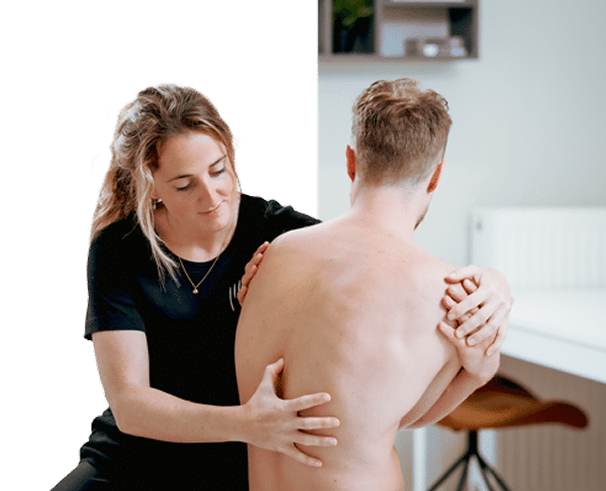What are forearm complaints
Forearm pain is discomfort in and around the tendons, muscles and tendon sheaths of the forearms. Pain may feel localized in the forearm but may radiate to the wrist, elbow or hand. Tension in the neck and shoulder girdle can intensify the picture. Complaints often arise from repeated pinching and twisting movements or sudden intense exercise.
Symptoms of forearm pain
- Pain in forearms and wrists when grasping, lifting or typing.
- Pain in elbows and forearms during pinching or twisting.
- Muscle pain forearms after sports or working with tools.
- Pain in forearms at night with stiffness when getting up.
- Tingling forearms and hands or feeling weak in grip.
Recognize these signs. Have your symptoms assessed. Starting early speeds recovery.
Causes of forearm pain
Frequently and unilaterally loading the forearms stimulates tendons and tendon sheaths. Building up quickly with forearm training or working with heavy tools increases the risk of strain. Exercises forearm training with too high intensity, for example forearm training dumbells or forearm training pinchers without building up, can provoke complaints. An unfavorable workstation or prolonged use of a mouse causes extra strain. Nerve irritation can play a role, causing radiating pain or numbness. Skin complaints such as itching on forearms, rashes on forearms or eczema on forearms should be seen by a doctor or dermatologist. Bruises on forearms after bumps are usually harmless and recover with rest.
What you can do yourself
- Alternate load and rest and take short micro-breaks during work.
- Keep wrists neutral at keyboard and mouse and support forearm on desktop.
- Warm up gently before exertion and cool briefly in case of obvious overexertion or bruising.
- Temporarily lower the training stimulus and choose technique over weight.
- Schedule short walks daily for blood flow and recovery.
- Is the pain getting worse or recurring. Schedule an intake.
Forearm pain treatment at The Physio Man
We start with an intake and a clear analysis of your load. We test grip strength, tendon glide tests, wrist and elbow mobility and look at neck and shoulder girdle. This is how we determine what triggers your symptoms and what adjustments provide immediate relief.
A treatment program usually consists of
- Exercise therapy with targeted tendon loading and strength for flexors and extensors.
- Mobilizations of wrist, elbow and upper back as needed.
- Nerve gliding exercises for prickling or tingling.
- Workplace and technology advice for keyboard, mouse and tools.
- Build-up schedule with measurable steps and clear pain boundaries.
Exercises for forearms
Perform exercises in a controlled and pain-free manner. These are safe options for forearm exercises at home and in the gym.
- Tendon sliding Gently make a hook hand, flat fist and full fist and return to open hand. Ten repetitions.
- Isometric squeeze Squeeze lightly into a soft ball five to 10 counts and relax. Eight to ten repetitions
- Wrist curls Forearm supported. Bend and extend the wrist with a light dumbbell. Three times ten repetitions.
- Pronation and supination Hold a hammer or short stick and rotate inward and outward in a controlled manner. Ten per side.
- Extensor stretch Arm extended, palm down. Gently pull the fingers toward you and exhale. Twenty seconds three times.
A slight after pain that subsides within a day is acceptable. Does the pain increase the next day. Lower the stimulus.
Skin and soft tissue around the forearms
Itchy forearms, itchy forearms or itchy forearms and lower legs are seen with skin irritation or sun allergy forearms. Red rash forearms or eczema on forearms sometimes require ointment or an assessment by the doctor. For extensive bruising or wound that does not heal contact your doctor.
When immediate help is needed
- Sudden loss of strength, loss of feeling or increasing numbness in hand or forearm.
- Rapidly increasing swelling, redness or fever combined with pain.
- Nighttime pain with unexplained swelling or a wound that does not close.
- Visible stance change after trauma or suspected tear.
In these situations, contact your doctor or urgent care immediately.
Frequently Asked Questions
How to train your forearms safely
Start with low intensity and perfect technique. Combine isometric squeeze exercises, wrist curls and pronation supination. Forearm training at home can be done with elastic bands, light weights and a soft ball. Rest between stimuli prevents overexertion.
What to do in case of pain in forearms and wrists or pain in elbows and forearms
Temporarily reduce the load, correct the workstation and start controlled exercises. If pain persists or there is tingling or loss of strength. Schedule an intake.
Why do I have pain in the forearms at night
This often fits overuse during the day or sleeping with flexed wrists. A neutral cushion for the arm or a soft wrist roller can help in addition to exercise therapy.
How to get thicker forearms responsibly
Muscular forearms are achieved with progressive strength training and adequate recovery. Vary grips, use pegs and light dumbbells and build up slowly. Nutrition and sleep support growth.
Your next step
Don’t stick around with pain or uncertainty. With a clear diagnosis and a smart plan, you’ll regain confidence in grasping, lifting and training.
Make an appointment at The Physio Man now and work with us to build strong, functional and pain-free forearms.
Share this article:


